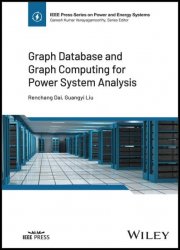Graph Database and Graph Computing for Power System Analysis
- Добавил: literator
- Дата: 9-10-2023, 17:48
- Комментариев: 0
 Название: Graph Database and Graph Computing for Power System Analysis
Название: Graph Database and Graph Computing for Power System AnalysisАвтор: Renchang Dai, Guangyi Liu
Издательство: Wiley-IEEE Press
Год: 2024
Страниц: 514
Язык: английский
Формат: pdf (true), epub
Размер: 24.3 MB
Understand a new way to model power systems with this comprehensive and practical guide.
Graph databases have become one of the essential tools for managing large data systems. Their structure improves over traditional table-based relational databases in that it reconciles more closely to the inherent physics of a power system, enabling it to model the components and the network of a power system in an organic way. The authors’ pioneering research has demonstrated the effectiveness and the potential of graph data management and graph computing to transform power system analysis.
Graph Database and Graph Computing for Power System Analysis presents a comprehensive and accessible introduction to this research and its emerging applications. Programs and applications conventionally modeled for traditional relational databases are reconceived here to incorporate graph computing. The result is a detailed guide which demonstrates the utility and flexibility of this cutting-edge technology.
Databases play an important role in scientific and non-scientific applications. In power system analysis, equipment such as generators, transmission lines, transformers, loads, shunt capacitors/reactors, circuit breakers, nodes, buses, and their properties are typically organized in structured tables in a database. In power system applications, relational databases are widely used to store and manage power system data and models. To adapt to the real-time application of the power system, in-memory databases and hierarchical databases are developed to maintain the real-time topology and dynamic operating conditions of the power system. In-memory databases and hierarchical databases are essentially derived relational databases for storing and managing structured data and information.
In contrast, a graph database is a database that models a system and stores information using a graph structure with vertices, edges, and attributes of vertices and edges. Edges describe the relationship between vertices. The data structure in a graph database is very different from a traditional relational database. Relationships are built directly into the graph database as given properties. In a relational database, the relationship between the vertices is implicit and indirectly established through analysis and calculation.
The book’s readers will also find:
Design configurations for a graph-based program to solve linear equations, differential equations, optimization problems, and more
Detailed demonstrations of graph-based topology analysis, state estimation, power flow analysis, security-constrained economic dispatch, automatic generation control, small-signal stability, transient stability, and other concepts, analysis, and applications
An authorial team with decades of experience in software design and power systems analysis
Contents:
Graph Database and Graph Computing for Power System Analysis is essential for researchers and academics in power systems analysis and energy-related fields, as well as for advanced graduate students looking to understand this particular set of technologies.
Скачать Graph Database and Graph Computing for Power System Analysis
Внимание
Уважаемый посетитель, Вы зашли на сайт как незарегистрированный пользователь.
Мы рекомендуем Вам зарегистрироваться либо войти на сайт под своим именем.
Уважаемый посетитель, Вы зашли на сайт как незарегистрированный пользователь.
Мы рекомендуем Вам зарегистрироваться либо войти на сайт под своим именем.
Информация
Посетители, находящиеся в группе Гости, не могут оставлять комментарии к данной публикации.
Посетители, находящиеся в группе Гости, не могут оставлять комментарии к данной публикации.

